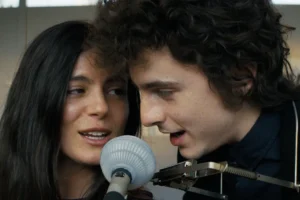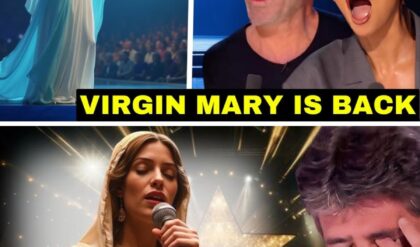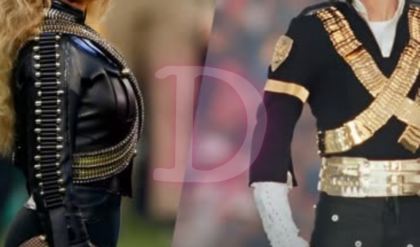“How does it feel?” is one way by which to measure a movie. But if you’ve seen “A Complete Unknown,” the Bob Dylan biopic that opened on Christmas Day, you may have left the theater singing to yourself (to the tune of “Like a Rolling Stone”): How much is reeeaaallll?

The short response is: A lot. But the long answer involves acknowledging director James Mangold’s film taking liberties in terms of a condensation of timelines, the conjoining of separate incidents, fictional character names in a couple of cases, and moments of sheer imagination and fictionalization. It’s certainly possible to enjoy “A Complete Unknown” without stressing too much over which parts are fact and which are fanciful. But for those who want to take a deep dive into how much the movie aligns with the known historical record, we looked to several Dylan experts to help sort it out.
Our primary guide is Elijah Wald, who literally wrote the book on this subject — as in, the 2015 book that was optioned and gets a “based on” credit at the beginning of the film: “Dylan Goes Electric! Newport, Seeger, Dylan, and the Night That Split the Sixties.” He’s very high on the film, even though he’s independent enough from it to point out areas where the screenplay deviated from his source material. We also talked with David Browne, author of the recently released “Talkin’ Greenwich Village: The Heady Rise and Slow Fall of America’s Bohemian Music Capitol,” who is similarly a fan of the film, even if it sketches the folk scene in shorthand. Finally, we discussed it with Ian Grant, a Dylan buff who is the co-host of two Dylan-centric podcasts, “Jokermen” and “Never Ending Stories,” the latter of which last week featured a heated discussion of the movie’s accuracy.
Mangold recently told Variety that the film is “not a Wikipedia entry” and he didn’t feel a fealty to a documentary level of facts — but also pointed out that, besides relying on Wald’s book and other historical source material, he based his version of the script (co-written with Jay Cocks) on many hours he spent personally talking with Dylan. In any case, many of those who’ve been in Dylan’s orbit over the years have given it high marks. Kevin Odegard, who played guitar on “Blood on the Tracks,” wrote, “We loved every minute… Critics who pick apart the imaginative world of composite characters and compacted historical footnotes are the dogs who caught the car. They miss the emotional punch of James Mangold’s poignant Hollywood movie.” And Ronee Blakley, a veteran of the Rolling Thunder Revue tour, wrote, “I am happy for Bob to be so carefully portrayed that his legacy stirs excitement today just as it did then, his magic and greatness self-evident and timeless. And we get a glimpse of what it cost him. Timothée Chalamet deserves an award, as does the picture.”
Here are some burning questions viewers might have after seeing the film, followed by some burning answers.
At the Newport Folk Festival of 1965, did a dismayed fan yell out “Judas!” — to which Dylan replied, “I don’t believe you… you’re a liar”?
No… not there. But as most hardcore Dylan fans will know, that exact exchange with the audience did happen a year later, at a 1966 U.K. gig in Manchester that was widely distributed as a bootleg and eventually officially released. So Mangold has combined two incidents in which at least some of the audience was rebelling against Dylan transforming himself into a rock ‘n’ roller. Podcaster Grant, who has a few other problems with the film, doesn’t think this conflation counts as one. “Ultimately, that’s just sort of nerdy fan trivia-type stuff, so I don’t really think that has a fundamental impact one way or another on the quality of the movie,” he says.
How accurate, otherwise, is the climactic depiction of Dylan’s appearance at Newport in 1965 … especially the crowd reaction, booing included?
Says Browne, “If any moment in music history was born to be a scene in a biopic, it’s Dylan plugging in at that Newport — from (Pete) Seeger and the ax to the crowd reactions to Dylan returning to the stage with ‘It’s All Over Now, Baby Blue’ (as a comment to the crowd … or not). Overall, I thought the film did a good job recreating that explosion at Newport, even if the crowd shots seem a bit over the top.”
In his “Dylan Goes Electric” book, Wald devotes thousands of words to recounting that fateful day, based on first-hand accounts… many of which substantially differ from others. “There were 17,000 people there,” the author points out. “Depending on where you were standing, I’m sure there were people who were surrounded by people booing, people who were surrounded by people cheering, people who heard a bit of both, people who thought everyone was just confused. Those are all accurate memories of the people around you, in a crowd of 17,000, right?”
The problem in coming up with any kind of accurate consensus reaction, he says, is that “during the electric set, the microphones were turned way down because the amps were so loud on stage, so there’s no record recorded of what was happening in the audience. But critic Robert Shelton was in the audience, covering it for the New York Times. He was keeping a notebook at the time, and after ‘Maggie’s Farm,’ he writes in his notebook: ‘Some booing.’ He was writing that as things were happening, so that’s not hindsight. But none of that’s on tape. Once the band got off stage and Peter Yarrow came up to try to quiet the crowd, the microphones were turned up and then you can hear the crowd. And there are people yelling for Dylan to come back. There are also people yelling, ‘Bring back Pete Seeger.’ There are people yelling for (Dylan) to get ‘a wooden box,’ which I take to mean an acoustic guitar. There are people yelling at the other people to shut up. I mean, it was a very confusing scene.”
Wald adds, “The best example I have of that is a friend of mine who was there, who has absolutely clear memories of how much he loved Dylan’s electric set — and also absolutely clear memories of coming back from Newport with a picture of Dylan on the inside of his guitar case, which he’d crossed out because he was so angry about Dylan’s electric set. And I think that’s not atypical. There were a lot of people who were upset in the moment and very quickly fell in love with the electric stuff.”
A complicating factor in telling this story: Prior to the contentious Sunday electric set, Dylan had done an acoustic performance at the festival, on Saturday … during which some people attending Newport for the first time were unhappy he wasn’t doing his new electric material! “When he went on for his acoustic set on Saturday afternoon, you can hear the audience (on tape) — there are all these people yelling for him to play ‘Like a Rolling Stone,’ because that was the hit on the radio right then. There were a lot of people who had come to Newport just to hear Bob Dylan, the friend of the Beatles, play ‘Like a Rolling Stone’ and who were being really obnoxious about the other acts. Some of the people at his afternoon set were yelling at the people on the banjo stage to quiet down so they can hear Bob Dylan. So there was already a lot of irritation at the festival before he ever got on stage the next night.”
Did Pete Seeger really think about taking an ax to cut the cables as Dylan was alienating some festivalgoeers with his electric set?
In the film, this legend is given a nod just by Seeger (played by Edward Norton) glancing at an ax, but not actually picking it up. “I thought how they handled the ax thing in the film was pretty goddamn smart,” says Wald, even though his book goes to great lengths to discredit the idea that Seger was ever in danger of picking one up.
Even Seeger eventually “said that ‘if I had an ax, I’d have cut the sound cable’ — which is just an invention. I mean, the whole ax thing was just because Peter Yarrow said (on the microphone to the crowd), ‘He’s gone to get his ax,’ when Dylan went to get a guitar” to perform the solo acoustic encore festival producers were begging for. Some heard the “ax” comment and believed Yarrow was referring to Seeger and a literal blade.
One thing Wald says is completely accurate in that moment: “I love that they show that Toshi (Seeger’s wife) is the one who calms him down, which, according to their daughter, is exactly what happened — that Pete was really upset and was trying to shut things down and Toshi said, ‘Hey, cool it.’”
Were Dylan and Johnny Cash devoted pen pals?
Yes, this is completely accurate. “The scenes in the airplane with them writing letters back and forth, those are direct quotations, in fact, from their letters,” Wald says. He quoted some of them in his book, and as Variety noted in its coverage of the opening of the Bob Dylan Center in Tulsa, some of those handwritten mutual fan letters are on display for fans to see up close.
Did an intoxicated Cash urge Dylan on in the latter’s desire to do a rock ‘n’ roll set at Newport ’65?
No, this particular meeting of rebellious minds is an invention of the screenplay. Cash wasn’t even at Newport in 1965, although he did famously play there the year before that. As for whether their scene together in a parking lot captures the spirit of Cash and of the relationship…
“Some of it feels real, some of it’s overdone,” says Wald. “With the Cash character, I think they overdo the goofiness a little bit. I don’t think he was destroying a lot of cars at Newport, and if he had, he’d have been more apologetic about it. I mean, Cash was very high on pills, as I believe probably Dylan was too. But although Johnny Cash was rowdy, he was not destructive in that particular way, and particularly at Newport, which was very important to Cash. He was very concerned with making a good impression at Newport because he was trying to break into the national, that is to say northern, college market. Everybody at Newport only got $50, so Johnny Cash was losing a lot of money by playing Newport, and he was there because he had the vision, which very few people in country music did, to see this potential audience for him, and he was recording Peter La Farge’s ‘Ballad of Ira Hayes’ out of (folk publication) Broadside Magazine. That’s one of the funny parts about all of this is, people positioning him as outside the folk scene. He was very much appreciating and trying to be recognized within that. That said, it isn’t a movie about Johnny Cash — Mangold already did that (with ‘Walk the Line’).”
Which completely fictional scene in the movie did Dylan make up and ask James Mangold to add to the screenplay?
The answer to that is completely unknown; Mangold is keeping that as a secret he holds close to his vest. But Wald is willing to hazard a hunch. “There’s this story that we’ve all heard that Dylan suggested that they add a completely fictitious scene, and nobody’s saying what it was. If I had to guess, I would guess it was the ‘Now, Voyager’ (recurring motif), just because it’s the only thing in that movie that I can easily imagine Dylan coming up with and can’t imagine someone else inventing as a part of his story.” The Dylan character and the one based on real-life girlfriend Suze Rotolo go see a revival movie early in their courtship, then reenact a moment from it in a bittersweet farewell at the climax of this film. “Because Dylan is an old movie fan, I can imagine him imagining acting out the Bette Davis/Paul Henreid scene from ‘Now, Voyager’,” Wald supposes. “It seems so unlikely to me that someone else would come up with that. When I see that, I go, ‘That’s cute.’ Did it happen? I have no idea.”
Going back to the beginning: Is the film’s portrayal of Dylan’s arrival in New York and quick integration into the folk scene accurate? And how about the quick sketches of the players on that scene circa 1961?
Browne, whose new “Talkin’ Greenwich Village” book lays out that folk scene in great detail, is perhaps naturally disappointed the movie skips glancingly through that period and its key figures. “As someone who spent a lot of time researching Dylan’s fellow Villagers of the time, and also meeting with and interviewing those still with us. I was struck by how few were depicted in the film,” Browne says. “Where are Phil Ochs, Tom Paxton, Len Chandler, Carolyn Hester and Terri Thal, Dylan’s first manager? From what I can tell, Dave Van Ronk — a towering figure even then, and someone Dylan respected, someone on whose couch he often crashed — is only in two fleeting scenes, and barely identified even then. Obviously one can’t make room for all of them in a movie like this, but without more of those characters, we don’t get as strong a sense of how disruptive Dylan was in the Village, and not just nationally. His rapport with Ochs could have made for a few meaty scenes; their rivalry embodied the topical-vs.-personal, acoustic-vs.-electric debates of the time.”
Besides his “Dylan Goes Electric!” book, Wald also published a biography of Dave Van Ronk, but he isn’t bothered that that influential singer is only identified in the end credits and not even referred to by name in the film. “Van Ronk is basically non-existent in the movie, and that’s fine. I’m not cranky about that,” Wald says. “Neuwirth has a slightly larger role that I think is handled rather nicely.”
Grant was thrown off by the congregation of boldface names right at the beginning. “Literally the first building he walks into in the entire city, Dave Van Ronk just comes up to him and starts talking to him, and then two hours later he’s out in New Jersey and he’s met both Woody Guthrie and Pete Seeger, all within about six hours of his arrival to New York. That had me rolling my eyes a little bit, even understanding that they’re gonna have to make exceptions to reality and abbreviate things for the dramatic arts’ sake.”
Did Dylan’s first performances galvanize audiences from the get-go?
Not as much as depicted in the film. Browne’s “Talkin’ Greenwich Village” book says that early Dylan gigs found him “awkward and out of place one moment, assured and in command the next,” with a co-manager of the Gaslight saying he was initially “disastrous” and a Daily News reporter saying he “left the stage to the sound of perhaps one hand clapping.” Certainly Shelton, Albert Grossman, Joan Baez, et al. were never in the same room on the same night, as portrayed.
Says Browne, “In talking with people from the scene and reading first-hand accounts from those who have since passed, I was struck by how jarring Dylan’s voice, guitar playing and early repertoire were to so many in the Village at the time. His approach wasn’t as formal as some of the area folk singers who’d come before him in the ‘40s and ‘50s; with his phrasing, humor and energy, he injected a far more rock ‘n’ roll sensibility onto those tiny stages. That roughness captivated some and caused others to bristle, and we don’t get much of that sense in the film. It wasn’t love at first sight or sound for everyone.”
Robert Shelton of the New York Times wrote that he was “bursting at the seams with talent” only upon seeing him a second time at Folk City — a notice that made a big difference in Dylan’s career. So Browne was happy to see him portrayed in the movie. “In terms of the local press, Shelton practically had the folk club to himself, and in the New York Times to boot. He also championed everyone from Buffy Sainte-Marie to Eric Andersen, helping with their careers. Speaking as a journalist myself, one of my takeaways from my research was the power of the press in those days. Even in the ‘70s, newer Village acts like Steve Forbert, the Roches and Willie Nile landed record deals right after they were praised by Times critics John Rockwell and Robert Palmer. How often does that happen now?”
Did his first encounter with Joan Baez involve insulting her from the stage after following her at a NYC folk club?
That’s invented. In fact, Baez wasn’t hanging around New York at all. “Joan did not like New York. She was from Cambridge, which as a group considered themselves the purists and the New York people to be running after the money. Joan was the prime example of that, turning down Columbia Records and Albert Grossman and staying in Cambridge and then going off to Carmel, California. Bobby Neuwirth was also Cambridge, not New York. But you have to simplify stuff like that, and I think it was a good choice for the movie.”
Says Browne, “As Baez told me in an interview for the book, she and Dylan first met outside Gerde’s Folk City in 1961. She’d driven from Boston to the city to attend a protest in Washington Square Park (the infamous “Beatnik Riot”) and just missed it – but, since she was there, decided to check out this kid she’d already started hearing about. She was struck by his stage presence right away, and he introduced himself to her outside the club and sang her a song, but there’s no record of any initial cutting remarks. She also didn’t realize he was more, um, intrigued by her sister Mimi than her at the time.”
How about the portrayal of Joan Baez in general?
“I was utterly blown away by (Monica) Barbaro’s singing,” says Wald. “Going in, I had thought a good actor can act Bob Dylan singing, because Bob Dylan singing is all about the phrasing, but acting Joan Baez’s voice, which is all about the instrument — I thought Barbaro did an astonishing job. She doesn’t sound exactly like Joan, but boy, she sure as hell sounds good.”
Says Grant, “I think that she’s given a relative fair shake in the movie. The film paints her in a more fair and attractive light than someone like Joan Didion did. I don’t know if you’ve ever read Joan Didion’s writings about Joan Baez, but it’s a brutal dressing-down, unfairly. in many cases. But I think she’s fairly drawn, and is more interesting and comes across as more of a real human being than the Suze Rotolo character, or Sylvie Russo as she’s called in the movie.” Grant also liked the way a Halloween 1964 interchange between Dylan and Baez on stage at a New York Philharmonic show was portrayed. “They end up almost getting into this fight up there on stage — that’s a fun and, I think, a well-drawn scene. That’s one of the great early solo acoustic performances by Bob, right before he’s about to go into electric mode the following year — and the relationship dynamic, I think, between him and Joan is one of the best parts of that performance.”
How about the Sylvie character, who everyone agrees to assume is meant to be Suze Rotolo?
Says Wald, “They changed Suze’s name and fictionalized her a good deal. But honestly, I had been afraid that they would just make her the nice girl next door, who he left for the mysterious Joan, rather than being the political conscience who got him into political music. So I was really pleased that they have her working for CORE and getting Dylan out to political things. And I was pleased that they have her leaving him rather than vice versa.”
Grant says that the movie accurately indicates that “she is the one that introduced Bob to political songwriting in the first place, by kind of bringing him into a lot of the student actions and rallies and meetings and stuff that she had already been attending by the time Bob showed up. They do gesture at that in the movie, but I think she’s really just turned into wallpaper by the end of the picture.”
Says Browne, “Suze is accurately portrayed in the film as an artist and creative and someone who deepened his interest in politics, but she also expanded his love of literature and was a vital link in the chain between him and Village culture overall, which isn’t sketched out quite enough. (Speaking of which, her artwork and illustrations also inspired his own drawings.) But the way she starts to wonder about him, his mysterious background and the impact of his impeding fame feels true to what friends have told me about her and what comes across in her memoir.”
No. The movie is ambiguous about why Dylan offers to drive Rotolo to the festival on his motorcycle and then leaves her to tearfully witness his chemistry with Baez — whether there is lingering romantic interest there. In any case, Rotolo did not attend the festival and was long out of his life romantically by then. So was Baez, for that matter, though they still shared some stages.
“I found it odd that the film has Bob and ‘Sylvie’ reuniting just before Newport ’65 and the riding up there together on his motorcycle,” Browne says. “In real life, Dylan and Rotolo had already dissolved as a couple. That felt more like a Hollywood contrivance (a Bob-Com?), and I suppose it also helped shape and resolve the Bob/Joan/’Sylvie’ entanglement, but that felt like a highway 61 too far.”
Apparently even Dylan riding a motorcycle to the festival in ’65 — solo or otherwise — is an invention, although besides symbolizing personal freedom, it also has the “Lawrence of Arabia” effect of foreshadowing a motorcycle crash to come the following year… one that many believe led to a temporary end to the “goes electric” period and helped bring on yet another reinvention.
Is there any potential major character that’s left out completely?
It’s funny you should ask that. Grant’s big beef with the movie (one that was also expressed by New Yorker critic Richard Brody, whom Grant amplified on social media and in a Jokermen podcast): the lack of any mention of Sara Lownds, who was soon to become Sara Dylan. Lownds and Dylan first got together romantically in 1964, and by the time Newport ’65 transpired, they’d already taken a lengthy vacation together. He married her just a few months after Newport. But she’s not mentioned in the movie.
“She doesn’t exist in this reality, basically,” says Grant. “Meanwhile, Joan Baez and Suze, or Sylvie, are two characters meant to stand for two different ways of being in the world, positioned against one another. Bob obviously is drawn to elements of each, but ultimately decides that neither of them is as important to him as his ability to continue to follow the muse. But in reality, he does find the perfect person for him, a romantic partner that works with his creative life, and with whom he actually strikes up a very rich and rewarding family life just after this movie ends — and was already involved with at the time — in Sara. It tells a false sort of a half-truth at best, if not an outright fabrication, about Bob’s relationship to romantic partners in his life. The movie does nail aspects of that, certainly, with these characters and kind of the dirtbag way he treated some people early on. But to present this as sort of the defining holistic picture of this man, when obviously he is fundamentally a different human being at this moment in time, to say nothing of the ways that he’s going to change in the months and years to come, just sort of strikes a downward note to me.”
Grant adds, “The Suze character in the picture is representative of kind of the civilian way of life, or the non-arts way of being in the world. The character paints and she’s active in the left student movement, but she’s fundamentally just kind of like a ‘normal person’ as opposed to someone like Bob Dylan or Joan Baez, who are these generationally talented celebrity artists. The Suze Rotolo character is unsatisfactory for him, because he’s too big, too brilliant, too brash to settle down with someone like that. In reality, he does settle down with someone like that. Obviously Sara is a very different person than Suze herself. But I think on that basic understanding level of someone who isn’t running in the scene, someone who isn’t obsessed with celebrity, someone who isn’t out to make a name for themselves, that’s exactly the kind of person that he ends up spending the next 10 years being married to.” Because so much of Dylan’s music over the next 13 years was inspired by Sara, both in romance and ultimately in divorce, Grant says “that to me is such a ‘Rosebud’ type of thing, to borrow ‘Citizen Kane’ terminology, in Bob’s life. That is the single source which so many decisions are made out of and so many songs written from. So, I think that kind of why I’m so hyperfocused on that element of things here.”
As for why Dylan’s then-romantic partner and future wife isn’t portrayed in the final stretch of the film, it may be because a romantic quadrangle was a bridge too far for the scriptwriters. Or, in Grant’s view, because Dylan is committed to keeping his former wife out of things, since she has chosen to live a private life and not comment publicly on their relationship, as Suze Rotolo finally did before the end of her life, with a memoir. (Even then, Dylan was protective in insisting Rotolo be fictionalized for the film.) Grant counters that by noting that the Dylan/Lownds relationship was dramatized in the Heath Ledger segment of Todd Haynes’ 2007 “I’m Not There” movie, albeit with everyone in that portion — the Dylan character included — being identified by pseudonyms.
On a more mundane note… how accurate are some of the studio moments portrayed in the film? Like Al Kooper playing the organ part on “Like a Rolling Stone” spontaneously, as a non-organ player?
There are a lot of what might be considered Easter-egg moments for Dylan fans to latch onto. For example, when “Like a Rolling Stone” is being recorded, the musician Al Kooper comes to the studio, announces himself as the guitar player, and is informed that they already have one of those, so he places himself at the organ instead, playing what becomes a world-famous part, despite his discomfort with the instrument. As a whole, that’s true, although it didn’t happen in the matter of virtual seconds it does on film, and the band wa a few takes in before those famous licks started up.
On the other hand, Kooper gets short shrift as the actual purchaser of the police whistle heard on the “Highway 61 Revisited” album; the movie shows Dylan being inspired to pick that up from a street vendor on his own.
Moving back to Newport ’65… did manager Albert Grossman and folk music legend and festival mainstay Alan Lomax really get in a physical struggle?
Yes, although not during or about Dylan’s performance. Wald doesn’t mind that the fight got transferred from one moment to another, since he’s pleased about the portrayal of Lomax generally.
“I think they got some things right about Lomax that everybody gets wrong and that nobody will notice that they got right except me,” Wald says. “Everybody has Lomax as being anti-electricity, and that’s absolutely wrong. Lomax was, in fact, I think the first folklorist ever to record a band with an electric guitar back in the ‘40s. Lomax thought rock ‘n’ roll was great! What set him off at Newport was the Paul Butterfield Band, and it was not that they were playing loud electric music. It was that he was the guy who had discovered Muddy Waters, and he was upset that the first electric band invited to Newport was a bunch of white college kids. They have exactly that scene in the movie with him complaining about them being a white band who is fake and being brought in because Grossman is managing them. Which wasn’t quite true; he was still courting them. I do think everybody will see the film and walk out still thinking that Lomax hated electricity, even though they don’t say that, because that has become the myth. His fight with Grossman was real, but had nothing to do with Dylan.”
Adds Wald, ”The funny thing about Lomax is, Lomax had no more time for Dylan as an acoustic singer-songwriter than as an electric singer-songwriter. He liked folk music as the music of the peasantry and the proletariat, and he thought people like Dylan and the New Lost City Ramblers and Dave Van Ronk were fake — and it had nothing to do with electric and acoustic… which, as I say, the movie actually got right, but not in a way that anybody but me will notice. I also don’t think that scene ever happened in the board meeting, where he blows up and Peter Yarrow walks out. I don’t think that’s ‘real,’ but it’s true — it’s completely accurate to the people.”
Did Dylan really sit in on an episode of Pete Seeger’s TV show with the host and a blues player?
No — that scene is fictional, and so is the entire character of the bluesman, “Jesse Moffette” (played by real-life blues guitarist Big Bill Morganfield). And yet Wald is delighted by the scene because it illuminates a versatility and curiosity that the author thinks Seeger doesn’t get enough credit for.
“I’ve never been in rooms with Dylan, so I can’t speak to that, but I knew Seeger, and Ed Norton as Seeger… both I and people who knew Pete much better than I did are blown away. Even more than that, they got the music right from beginning to end, and there’s so much music, and not just Dylan’s music. That scene where Dylan and Big Bill Morganfield are playing blues together and Seeger starts playing banjo along with them — now, that didn’t happen, but that’s exactly the way Seeger played banjo when he was jamming with blues people. And most people aren’t even aware that Pete Seeger could jam on a blues, including a lot of people who were pretty deep in the scene. That’s absolutely accurate, except that particular meeting didn’t happen in that particular place.”
Were Dylan and Seeger really buddies upon first meeting?
Dylan did not stay over at Seeger’s house the first night he got to New York, or probably any other night — though that does kind of stand in for his weeks or months of known couch-surfing with other friends. Says Wald about his source book, “I built a narrative that followed Seeger and Dylan as the two main characters. To turn that into a movie, you have to actually put them in the same room a bunch and have them relating to each other more than they really did. They made it work dramatically as a personal friendship more than it was in real life. But I think that worked very effectively.”
What about the portrayal of Seeger generally — does he get a fair and accurate shake? And is the film really about folk versus rock?
Says Wald, “I’m so used to people who are doing the Dylan story being interested in Dylan and casting Seeger as one of the boring old folkies. What I was trying to do in my book was suggest that he was as complicated and in some ways as difficult a person as Dylan, and that they just were on different paths — sometimes the same, but at that moment, at Newport, very much not. But then again, after that, (they remained friends), which is another thing I liked about the movie.”
And even if it was concocted, Wald loves having the movie end with a scene of Dylan back in Woody Guthrie’s hospital room playing harmonica along with “So Long, It’s Been Good to Know You” — an indication that the newly minted rocker really isn’t leaving folk behind at all, at least hardly for good.
“The way that story was told in the ‘70s always was from a rock point of view,” Wald says, “written by people who had never liked folk music and never liked Pete Seeger, and felt like the story was Dylan liberating himself from the boring old folkies and proving the rock ‘n’ rollers were right. By now, though, we all think of Dylan as deep Americana, someone who has remained very true to that tradition. And so I just think that that whole incident looks very different, not just in the film, but pretty much to anyone younger — it makes perfect sense to think of that moment as Dylan trying to break away from the folk scene, but not from folk music. Which is true.
“I mean, ‘Maggie’s Farm’ is sort of exhibit A. When Dylan is singing ‘Ain’t gonna work on Maggie’s farm no more’ at the beginning of the Newport ’65 performance, it’s absolutely a declaration of independence from that scene. But it’s based a song about sharecroppers, ‘Penny’s Farm,’ from the 1920s, which Pete Seeger had recorded in 1950!
“At the time, Seeger was really upset by what he heard as the aggression. What you see in the film, with Dylan and the guys with him being sick of being stuck in this box, and ‘we’re gonna show the goddamn folkies,’ I think that’s accurate. And there’s a thing I quote in my book that he wrote that very week where he said he felt it was angry and destructive. But he was a man given to a great deal of soul-searching. And he rather quickly decided that he had misunderstood, and that ‘Maggie’s Farm’ was in fact a brilliant song, and that Dylan had indeed been sort of crushed into a box and had to escape. And they made up and they continued to get together over the years.”
Any small but still really nagging objections?
Says Wald, “There’s some little things that bother me, not because they’re specifically inaccurate, they’re because they’re generally inaccurate. I mean, having the character refer to folk songs as ‘covers.’ Nobody said that until the late ‘80s, and the people who said that in the late ‘80s were people who didn’t like old folk songs. I don’t think Dylan to this day would refer to an old folk song as a cover. Nobody says that Doc Watson did covers, though he never wrote a song. So there are a couple of little things like that where I go, no.
“But in terms of turning history into historical fiction, the rule in that is being true to the people and the times and the place. And I think they do a very good job of that. I think it’s very funny, the people who are getting upset that it isn’t historically accurate. I mean, have they listened to Dylan’s songs? The silliest possible reactions I’m seen are people saying ‘I come out of the film and I don’t feel like I knew Dylan any better than I did going in.’ I mean, I feel like if I had come out of the film thinking I knew Dylan better, that he was a more knowable character, I would’ve felt like it was fake. I don’t know anybody who knew him in that time who didn’t feel like he was always kind of cagey. I mean, he was always making up stories about who he was… You know, brilliant 19-year-olds, the question of who they really are, I think no one can answer, including them. And brilliant 19-year-olds who, before they can even figure out who they are, are being hailed all over the place as a prophet and a messiah. I mean, Jesus, that’s gotta fuck you up.”





